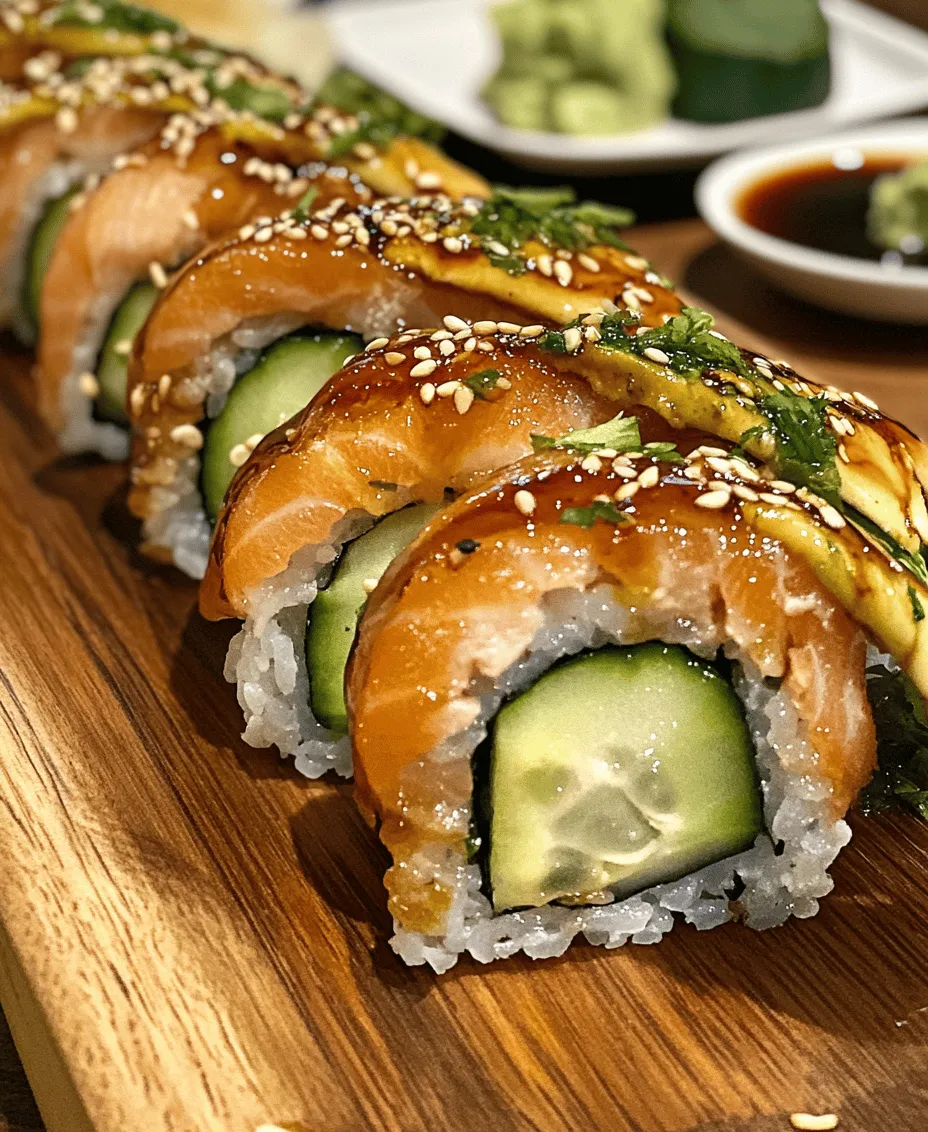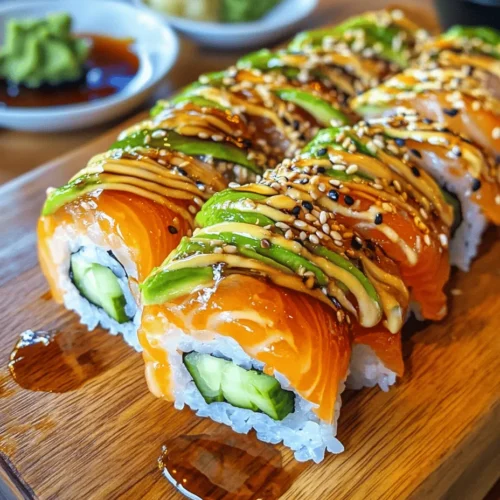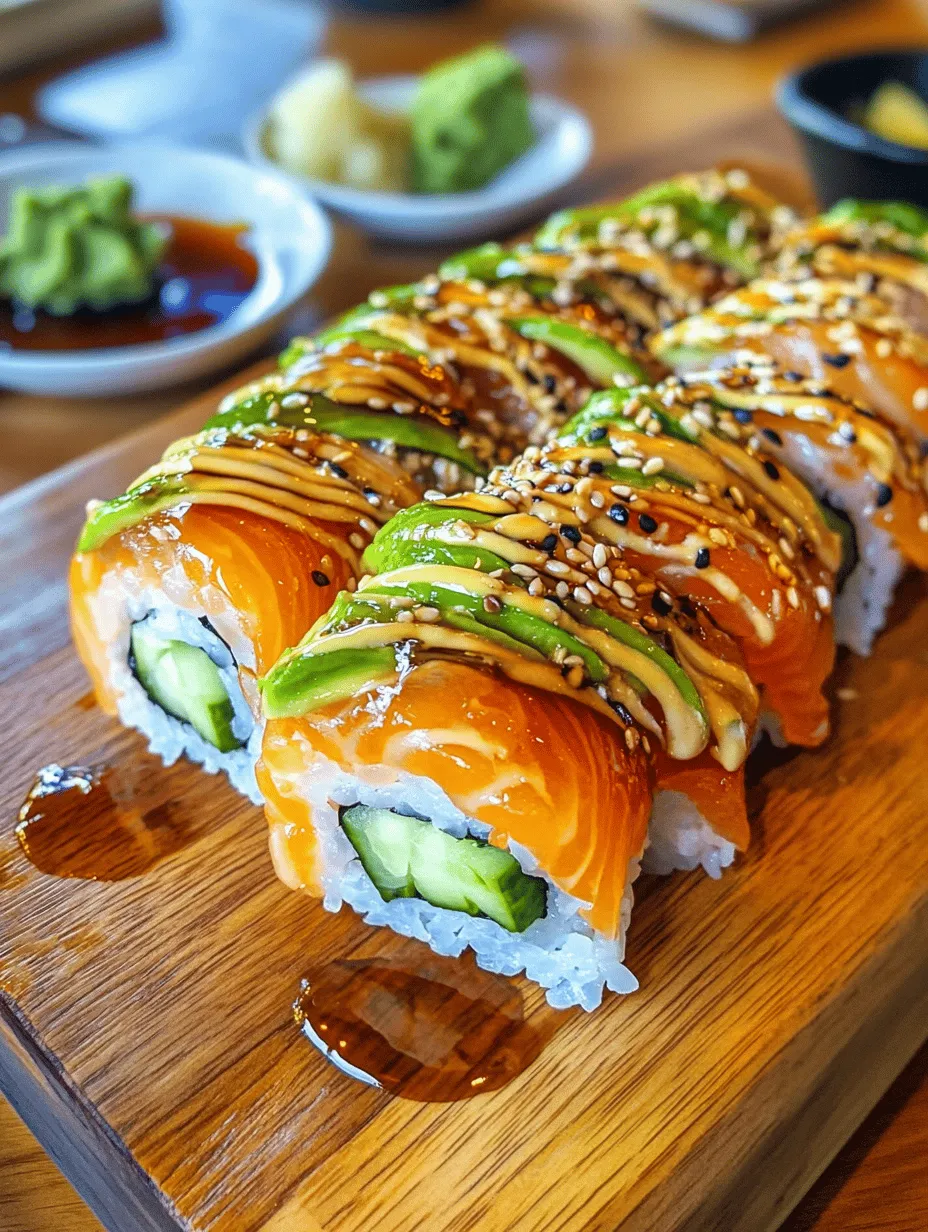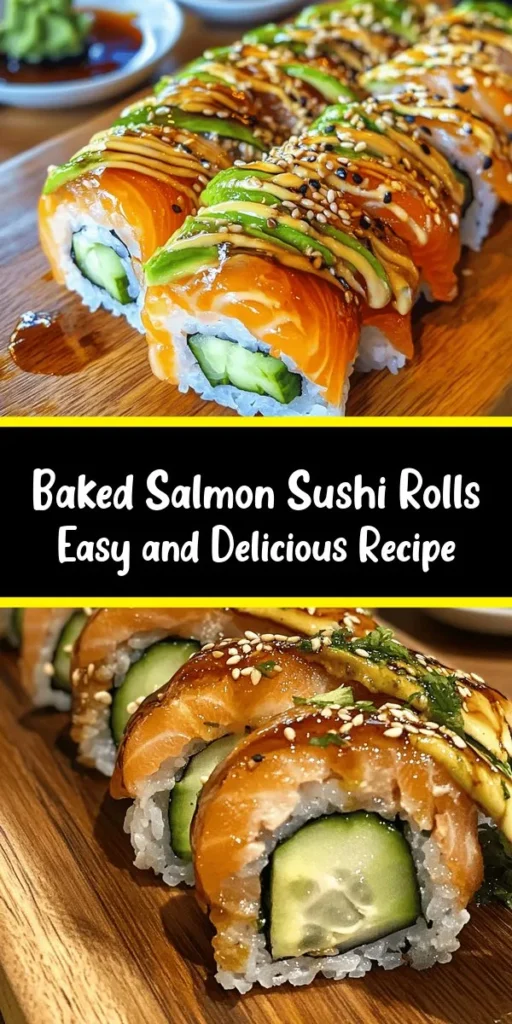Understanding the art of sushi-making can seem daunting, but with our Baked Salmon Sushi Delight, you’ll find a deliciously simple way to bring a taste of Japan to your kitchen. This recipe combines the rich flavors of fresh salmon with creamy avocado and crisp cucumber, all wrapped in perfectly seasoned sushi rice and nori. Ideal for family dinners or impressing guests, this dish is not only a feast for the palate but also a visual delight.
Sushi has a long and storied history, originating from ancient times when fish was preserved in fermented rice. This method evolved over centuries, with sushi taking various forms, including the popular nigiri and maki rolls we enjoy today. Our Baked Salmon Sushi Delight is a modern twist on traditional sushi, featuring baked salmon that enhances the flavors and makes it more accessible for home cooks. The baking process brings out the natural richness of the salmon, making it a satisfying centerpiece for your sushi rolls.
In this article, we will walk through the recipe, delve into its origins, nutritional benefits, and tips for perfecting your sushi-making skills. Whether you are a sushi aficionado or a beginner, this recipe will guide you through each step, ensuring a delightful and successful sushi-making experience.
Exploring the Ingredients
The Essential Components of Baked Salmon Sushi Delight
To create the perfect Baked Salmon Sushi Delight, it’s crucial to understand the ingredients that make this dish not just a meal, but an experience. Each component contributes to the overall flavor, texture, and presentation, transforming simple ingredients into a culinary masterpiece.
Sushi Rice
Sushi rice is the foundation of any sushi roll, and selecting the right variety is key to achieving the perfect texture. Authentic sushi rice is a short-grain variety that becomes sticky when cooked, allowing it to hold its shape when rolled. Look for sushi rice labeled as “shari” or “sushi mai” at your local grocery store or Asian market.
Before cooking, rinse the rice thoroughly under cold water to remove excess starch. This step is essential as it helps achieve a fluffy texture. The ideal sushi rice should be tender yet firm, with each grain distinct, creating a satisfying mouthfeel.
Fresh Salmon
The star of our dish is undoubtedly the fresh salmon. When choosing salmon, look for high-quality, sushi-grade fish, which indicates that it is safe to eat raw. The color should be vibrant, ranging from a deep orange to a bright pink, with a firm texture. The best options for sushi include Atlantic salmon or sockeye salmon, both known for their rich flavor and buttery texture.
Salmon is not only a delicious choice but also packed with health benefits. It is an excellent source of omega-3 fatty acids, which are essential for heart health, and it provides high-quality protein along with vital vitamins and minerals.
Seasoning Essentials
The seasoning of the sushi rice is critical to the overall flavor of your sushi rolls. The combination of rice vinegar, sugar, and salt creates a delicate balance of sweet and savory that complements the rich salmon. Typically, for every cup of uncooked sushi rice, you will need about 2 tablespoons of rice vinegar, 1 tablespoon of sugar, and a pinch of salt.
To prepare the sushi seasoning, gently heat the rice vinegar, sugar, and salt in a small saucepan until the sugar dissolves. Once the sushi rice is cooked and cooled, fold this mixture into the rice, ensuring that each grain is evenly coated.
Fresh Vegetables
In addition to the salmon, fresh vegetables play a vital role in enhancing the flavor and texture of your sushi rolls. Avocado and cucumber are popular choices, providing creaminess and crunch, respectively.
Avocado, often considered a superfood, is rich in healthy fats, vitamins, and antioxidants. When selecting avocados for sushi, choose ones that are ripe but firm, as they will provide the best flavor and texture.
Cucumber adds a refreshing crunch to each bite. You can use English cucumbers, known for their thin skin and minimal seeds, or Persian cucumbers for a slightly sweeter taste. Make sure to slice them into thin strips to ensure they fit well within the sushi roll.
Nori Sheets
Nori, the seaweed sheets used to wrap sushi, is another essential ingredient. It comes in various grades; for sushi, look for high-quality nori that is dark green and shiny, which indicates freshness. Nori sheets are rich in vitamins and minerals, particularly iodine, which is important for thyroid health.
Before using, you may want to lightly toast the nori over an open flame for a few seconds to enhance its flavor and make it more pliable. This step can also help prevent the nori from becoming too chewy after being wrapped around the sushi rice and fillings.
The Process of Making Baked Salmon Sushi Delight
Preparation Steps for Success
Once you’ve gathered all your ingredients, it’s time to dive into the preparation process. Each step is crucial and will help you achieve the best results for your Baked Salmon Sushi Delight.
Prepping the Sushi Rice
Start by rinsing the sushi rice under cold water. Place the rice in a fine-mesh strainer and run cold water over it until the water runs clear. This process removes excess starch, which is essential for achieving the right texture.
After rinsing, cook the rice according to the package instructions. Typically, sushi rice is cooked in a rice cooker or on the stovetop with a 1:1 ratio of rice to water. Once the rice is cooked, transfer it to a large bowl and let it cool slightly.
While the rice is cooling, prepare your sushi seasoning. In a small saucepan, combine the rice vinegar, sugar, and salt. Heat over low heat until the sugar and salt dissolve, but do not bring it to a boil. Once dissolved, let it cool slightly before folding it into the sushi rice. Use a wooden spatula to gently fold the seasoning into the rice, being careful not to mash the grains.
Baking the Salmon
As your rice cools, it’s time to prepare the salmon. Preheat your oven to 375°F (190°C). While the oven heats up, season the salmon fillets with a pinch of salt and a drizzle of olive oil. You can also add a splash of soy sauce or a sprinkle of sesame seeds for additional flavor.
Place the salmon on a baking sheet lined with parchment paper and bake for about 12-15 minutes, or until the salmon is cooked through and flakes easily with a fork. The baking process not only enhances the flavor of the salmon but also gives it a lovely, tender texture that balances beautifully with the sushi rice and vegetables.
Assembling Sushi Rolls
Once your rice and salmon are prepared, it’s time to assemble the sushi rolls. This step is where the magic happens, and with a few simple techniques, you can create beautiful sushi rolls at home.
The Role of the Bamboo Mat
A bamboo sushi mat is an essential tool for rolling sushi. It provides the support needed to shape and compress your rolls evenly. If you don’t have a bamboo mat, a clean kitchen towel can also work in a pinch.
Start by placing a sheet of nori shiny side down on the bamboo mat. Wet your hands to prevent the rice from sticking and grab a handful of sushi rice. Gently spread the rice evenly over the nori, leaving about an inch of space at the top to seal the roll later. Use your fingers to press the rice down lightly, ensuring it adheres to the nori without becoming too compact.
Layering the Ingredients
Now comes the fun part—layering your ingredients! Start with a few slices of the baked salmon, placing them in the center of the rice. Next, add slices of avocado and cucumber on top of the salmon. Be mindful of the balance of flavors and textures; you want each bite to offer a harmonious blend of creamy, crunchy, and savory.
Once you’ve layered your ingredients, it’s time to roll. Using the bamboo mat, lift the edge closest to you and begin to roll it away from you, tucking the filling as you go. Apply gentle pressure to shape the roll, ensuring it stays tight but not overly compressed. When you reach the exposed edge of the nori, wet it slightly with water to help it seal.
Continue rolling until you reach the end, then use a sharp knife to slice the roll into bite-sized pieces. Wipe the knife with a damp cloth between cuts to ensure clean edges.
With these steps, you are well on your way to mastering the art of sushi-making. The combination of fresh ingredients, flavorful salmon, and perfectly seasoned rice will make your Baked Salmon Sushi Delight a hit at any gathering. Stay tuned as we delve further into tips for perfecting your sushi rolls and explore the nutritional benefits of this delightful dish.

Rolling Techniques: Ensuring a Tight, Even Roll Without Squashing the Ingredients
Successfully rolling sushi is an art form that balances technique with finesse. To achieve a tight, even roll without squashing the ingredients, start by preparing your sushi mat. Lay it on a clean, flat surface with the bamboo side facing up. Place a nori sheet shiny side down on the mat, ensuring it covers about two-thirds of the mat.
Next, moisten your fingers with a little water to prevent the rice from sticking. Grab a handful of sushi rice and spread it evenly over the nori, leaving about an inch at the top edge free of rice. Press the rice down gently, ensuring it forms a thin, even layer.
Now it’s time to add your fillings. Place your baked salmon, avocado slices, and any additional ingredients like cucumber or spicy mayo in a line across the center of the rice.
To roll, start at the end closest to you and lift the mat while tucking the nori over the filling. Roll it away from you, applying gentle pressure to keep the roll tight but not so much that you squish the ingredients. As you approach the exposed edge of the nori, use a little water to seal it by moistening the edge before finishing your roll.
After rolling, use the mat to shape the sushi further. Gently press the roll to ensure it holds together, then let it rest seam side down for a few minutes before slicing.
Slicing and Serving Sushi
Once your Baked Salmon Sushi Delight is rolled and ready, it’s time to slice and serve. Proper slicing is crucial for presenting sushi beautifully and ensuring a pleasant eating experience.
Best Practices for Serving Sushi
When it comes to slicing sushi, the right tools and techniques make all the difference.
Tools for Slicing: The importance of a sharp knife and wet cloth cannot be overstated. A sharp, non-serrated knife will allow for clean cuts, preventing the roll from squishing and losing its form. Before you start slicing, wet your knife with water to help it glide through the roll smoothly, reducing stickiness.
Aim to cut the roll into 6-8 pieces, depending on your preferred portion size. Use a gentle sawing motion rather than pressing down hard, which can damage the roll’s integrity.
Presentation Tips: Creating an appealing plate is an integral part of the sushi experience. Arrange the sushi pieces neatly on a platter, ensuring they are spaced out for a clean look. You can garnish with thinly sliced green onions, sesame seeds, or microgreens for added color and texture.
Consider using a small dish for soy sauce, as well as placing a small mound of pickled ginger and a dab of wasabi alongside the sushi. This not only enhances the flavor but also makes for a visually appealing presentation.
Serving Suggestions: Pairing with Pickled Ginger and Wasabi for Enhanced Flavor
Sushi is often enjoyed with complementary condiments. Pickled ginger serves as a palate cleanser between different types of sushi, while wasabi adds a spicy kick. Both enhance the overall flavor profile of your Baked Salmon Sushi Delight.
For an added layer of flavor, consider serving your sushi with a drizzle of homemade sushi sauce (a mixture of soy sauce, rice vinegar, and a hint of mirin) on the plate. You can also pair your sushi with a refreshing drink, such as green tea or a light sake, to enhance the dining experience.
Nutritional Benefits of Baked Salmon Sushi Delight
Beyond its delicious taste, Baked Salmon Sushi Delight boasts numerous nutritional benefits, making it a wholesome choice for any meal.
Analyzing the Health Aspects
Nutritional Value of Salmon: Salmon is renowned for its high omega-3 fatty acid content, which is essential for heart health. Omega-3 fatty acids can help lower blood pressure, reduce inflammation, and may even improve brain function. Additionally, salmon is an excellent source of high-quality protein, vitamin D, and B vitamins, making it a powerhouse of nutrition.
Avocado’s Role in a Balanced Diet: Avocado is not just a creamy delight but also a nutritional superstar. Rich in healthy monounsaturated fats, avocados contribute to heart health and help in the absorption of fat-soluble vitamins. They’re also packed with fiber, vitamins C, E, K, and B6, making them an essential component of a balanced diet.
The Importance of Whole Grains: Sushi rice provides a source of energy, as it is made from short-grain rice, which is higher in starch. This type of rice offers quick carbohydrates, essential for energy. When combined with the healthy fats from salmon and avocado, this dish becomes a well-rounded meal.
Cultural Significance of Sushi
Sushi is more than just a food; it is a cultural phenomenon with rich historical roots.
Understanding Sushi’s Origins and Evolution
Brief History of Sushi: Sushi originated in Southeast Asia as a means of preserving fish in fermented rice. Over time, this practice evolved, and by the Edo period in Japan, sushi transformed into the form we recognize today. Originally, sushi was a way to enjoy fresh fish with rice, and it quickly gained popularity in Japan, eventually spreading worldwide.
The Rise of Sushi in Western Cuisine: In the late 20th century, sushi made its way into Western cuisine, becoming a global sensation. From sushi bars to grocery store sushi counters, the accessibility of sushi has led to its widespread appreciation. Today, sushi is celebrated for its artistic presentation and diverse flavors, often adapted to local tastes.
Sushi Etiquette: Understanding sushi etiquette can enhance your dining experience. Traditionally, sushi is eaten with chopsticks, but it’s also acceptable to use your hands. When dipping sushi in soy sauce, only dip the fish side to avoid soaking the rice. Additionally, it’s common to enjoy a piece of pickled ginger between different types of sushi to cleanse your palate.
Conclusion
Baked Salmon Sushi Delight is more than just a meal; it is an experience that encapsulates the beauty of Japanese cuisine. By mastering this recipe, you not only gain a valuable culinary skill but also enjoy a nutritious and delicious dish that can be made in the comfort of your own home. Whether you are a seasoned chef or a novice in the kitchen, this sushi recipe offers a delightful journey into the world of sushi-making, filled with flavors, textures, and cultural appreciation.
As you roll, slice, and serve this delightful dish, you’re not merely preparing food; you’re embracing a tradition that spans centuries. The nutritional benefits, cultural significance, and sheer joy of creating something so beautifully crafted are just a few reasons to dive into making Baked Salmon Sushi Delight. Enjoy your culinary adventure!



